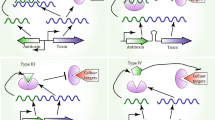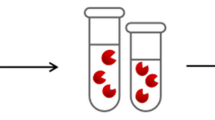Summary
The gene for Pseudomonas aeruginosa cytotoxin (CTX) has been found to be part of a temperate phage with a total size of 35.5 kb. We have investigated several DNA fragments of this phage for CTX production. For phage integration, the phage genome cohesive (cos) ends covalently associate with host DNA of strain PA158. The cos ends and the CTX gene are found on a 3.4 kb EcoRI fragment B and are included in the 11 kb HindIII fragment A and the 8.5 kb BamHI fragment B of the phage DNA. The cos ends are 20 nucleotides long and are located at 338–357 nucleotides upstream of the CTX transcriptional initiation site. The phage attachment (attP) site is also present on the 3.4 kb EcoRI fragment B. The attP site consists of 34 by and is located at 974–1007 nucleotides upstream of the CTX gene start site. Replication of the vegetative form of the phage is increased at 37° C compared to that at 30° C, while cytotoxin production in infected cells is similar at 30° C and 37° C. It can be concluded, therefore, that the integrated form of the CTX gene is responsible for CTX production. SDS-polyacrylamide gel electrophoresis (SDS-PAGE) showed ten proteins in purified phage preparations; however, CTX could not be detected on Western blots using an enzyme-linked immunofluorescence assay.
Similar content being viewed by others
References
Amann E, Ochs B, Abel KJ (1988) Tightly regulated tac promotor vectors useful for the expression of unfused and fused protein in Escherichia coli. Gene 69:301–315
Burke B, Griffith G, Reggio H, Louvard D, Warren G (1982) A monoclonal antibody against a 135-K Golgi membrane glycoprotein. EMBO J 1:1621–1628
Campbell AM (1962) The episomes. Adv Genet 11:101–145
Chesney RH, Scott JR, Vapnek D (1979) Integration of the plasmid prophages P1 and P7 into the chromosome of Escherichia coli. J Mol Biol 130:161–173
Duchrow M, Giffhorn F (1987) Physical map of the Rhodobacter sphaeroides bacteriophage ϕRsG1 genome and location of the prophage on the host chromosome. J Bacteriol 169:4410–4414
Gebeyehu G, Rao PY, SooChan P, Simms DA, Klevan L (1987) Novel biotinylated nucleotide-analogs for labeling and colorimetric detection of DNA. Nucleic Acids Res 15:4513–4534
Green M (1969) Chemical composition of animal viruses. In: Levy HB (ed) The Biochemistry of Viruses. Dekker, New York, pp 1–55
Hayashi T, Baba T, Matsumoto H, Terawaki Y (1990) Phageconversion of cytotoxin production in Pseudomonas aeruginosa. Mol Microbiol 4:1703–1709
Huang A, Friesen J, Brunton JL (1987) Characterization of a bacteriophage that carries the genes for production of Shiga-like toxin 1 in Escherichia coli. J Bacteriol 169:4308–4312
Kado CI, Liu ST (1981) Rapid procedure for detection and isolation of large and small plasmids. J Bacteriol 145:1365–1373
Kuzio J, Kropinski AM (1983) O-Antigen conversion in Pseudomonas aeruginosa PAO1 by bacteriophage D3. J Bacteriol 155:203–212
Lutz F (1979) Purification of a cytotoxic protein from Pseudomonas aeruginosa. Toxicon 17:467–475
Lutz F, Maurer M, Failing K (1987) Cytotoxic protein from Pseudomonas aeruginosa: formation of hydrophilic pores in Ehrlich ascites tumor cells and effect on cell viability. Toxicon 25:293–305
Martinez-Molina E, Olivares J (1979) Antibiotic production by Pseudomonas reptilivora as a phage conversion. Can J Microbiol 25:1108–1110
Matsuda M, Barksdale L (1967) System for the investigation of the bacteriophage-directed synthesis of diphtherial toxin. J Bacteriol 93:722–730
Miller RV, Rubero VJR (1984) Mucoid conversion by phages of Pseudomonas aeruginosa strains from patients with cystic fibrosis. J Clin Microbiol 19:717–719
Nakazawa T, Inouye S (1986) Cloning of Pseudomonas genes in Escherichia coli. In: Sokatsh JR (ed) The biology of Pseudomonas. The Bacteria, vol 10. Academic Press, New York, pp 357–382
Neu HC (1985) Ecology, clinical significance, and antimicrobial susceptibility of Pseudomonas aeruginosa. In: Gilardi G (ed) Nonfermentative gram-negative rods. Microbiology Series, vol 16. Dekker, New York, pp 117–158
O'Brien AD, Newland JW, Miller SF, Holmes RK, Smith HW, Formal SB (1984) Shiga-like toxin-converting phages from Escherichia coli strains that cause haemorrhagic colitis or infantile diarrhea. Science 226:694–696
Orlik-Eisel G, Lutz F, Henschen A, Eisel U, Struckmeier M, Kräuter J, Niemann H (1990) The cytotoxin of Pseudomonas aeruginosa: Cytotoxicity requires proteolytic activation. Arch Microbiol 153:561–568
Sambrook J, Fritsch EF, Maniatis T (1989) Molecular cloning: A laboratory manual. Cold Spring Harbor Laboratory Press, Cold Spring Harbor, New York
Scharmann W (1976) Formation and isolation of leucocidin from Pseudomonas aeruginosa. J Gen Microbiol 93:283–291
Schnaitman C, Smith D, Forn de Salsas M (1975) Temperate bacteriophage which causes the production of a new major outer membrane protein by Escherichia coli. J Virol 15:1121–1130
Xiong G, Lutz F (1992) Site-directed mutagenesis of the Pseudomonas aeruginosa cytotoxin for probing toxic activity. Eur J Biochem 204:789–792
Xiong G, Struckmeier M, Alberti U, Lutz F (1991) Relationship of primary structure to functional properties of the cytotoxin protein from Pseudomonas aeruginosa. Naunyn Schmiedebergs Arch Pharmacol 343:538–541
Author information
Authors and Affiliations
Additional information
Communicated by W. Goebel
Rights and permissions
About this article
Cite this article
Elsabbagh, H., Xiong, G. & Lutz, F. Nucleotide sequence of attP and cos sites of phage CTX and expression of cytotoxin in Pseudomonas aeruginosa PA158. Molec. Gen. Genet. 237, 421–428 (1993). https://doi.org/10.1007/BF00279447
Received:
Accepted:
Issue Date:
DOI: https://doi.org/10.1007/BF00279447




